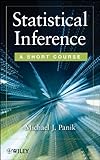Statistical inference : a short course / Michael J. Panik.
Material type: TextPublisher number: EB00066699 | Recorded BooksPublication details: Hoboken, N.J. : Wiley, 2012.Description: 1 online resource (xviii, 378 pages) : illustrationsContent type:
TextPublisher number: EB00066699 | Recorded BooksPublication details: Hoboken, N.J. : Wiley, 2012.Description: 1 online resource (xviii, 378 pages) : illustrationsContent type: - text
- computer
- online resource
- 9781118309780
- 1118309782
- 9781118309773
- 1118309774
- 9781118309803
- 1118309804
- 9781280699337
- 1280699337
- 519.5
- QA276.12 .P36 2011
Print version record.
A concise, easily accessible introduction to descriptive and inferential techniquesStatistical Inference: A Short Course offers a concise presentation of the essentials of basic statistics for readers seeking to acquire a working knowledge of statistical concepts, measures, and procedures. The author conducts tests on the assumption of randomness and normality, provides nonparametric methods when parametric approaches might not work. The book also explores how to determine a confidence interval for a population median while also providing coverage of ratio estimation, randomness, and causality.
Includes bibliographical references and index.
Statistical Inference: A SHORT COURSE; Contents; Preface; 1 The Nature of Statistics; 1.1 Statistics Defined; 1.2 The Population and the Sample; 1.3 Selecting a Sample from a Population; 1.4 Measurement Scales; 1.5 Let us Add; Exercises; 2 Analyzing Quantitative Data; 2.1 Imposing Order; 2.2 Tabular and Graphical Techniques: Ungrouped Data; 2.3 Tabular and Graphical Techniques: Grouped Data; Exercises; Appendix 2.A Histograms with Classes of Different Lengths; 3 Descriptive Characteristics of Quantitative Data; 3.1 The Search for Summary Characteristics; 3.2 The Arithmetic Mean.
3.3 The Median3.4 The Mode; 3.5 The Range; 3.6 The Standard Deviation; 3.7 Relative Variation; 3.8 Skewness; 3.9 Quantiles; 3.10 Kurtosis; 3.11 Detection of Outliers; 3.12 So What Do We Do with All This Stuff?; Exercises; Appendix 3.A Descriptive Characteristics of Grouped Data; 3.A.1 The Arithmetic Mean; 3.A.2 The Median; 3.A.3 The Mode; 3.A.4 The Standard Deviation; 3.A.5 Quantiles (Quartiles, Deciles, and Percentiles); 4 Essentials of Probability; 4.1 Set Notation; 4.2 Events within the Sample Space; 4.3 Basic Probability Calculations; 4.4 Joint, Marginal, and Conditional Probability.
4.5 Sources of ProbabilitiesExercises; 5 Discrete Probability Distributions and Their Properties; 5.1 The Discrete Probability Distribution; 5.2 The Mean, Variance, and Standard Deviation of a Discrete Random Variable; 5.3 The Binomial Probability Distribution; 5.3.1 Counting Issues; 5.3.2 The Bernoulli Probability Distribution; 5.3.3 The Binomial Probability Distribution; Exercises; 6 The Normal Distribution; 6.1 The Continuous Probability Distribution; 6.2 The Normal Distribution; 6.3 Probability as an Area Under the Normal Curve.
6.4 Percentiles of the Standard Normal Distribution and Percentiles of the Random Variable XExercises; Appendix 6.A The Normal Approximation to Binomial Probabilities; 7 Simple Random Sampling and the Sampling Distribution of the Mean; 7.1 Simple Random Sampling; 7.2 The Sampling Distribution of the Mean; 7.3 Comments on the Sampling Distribution of the Mean; 7.4 A Central Limit Theorem; Exercises; Appendix 7.A Using a Table of Random Numbers; Appendix 7.B Assessing Normality via the Normal Probability Plot; Appendix 7.C Randomness, Risk, and Uncertainty; 7.C.1 Introduction to Randomness.
